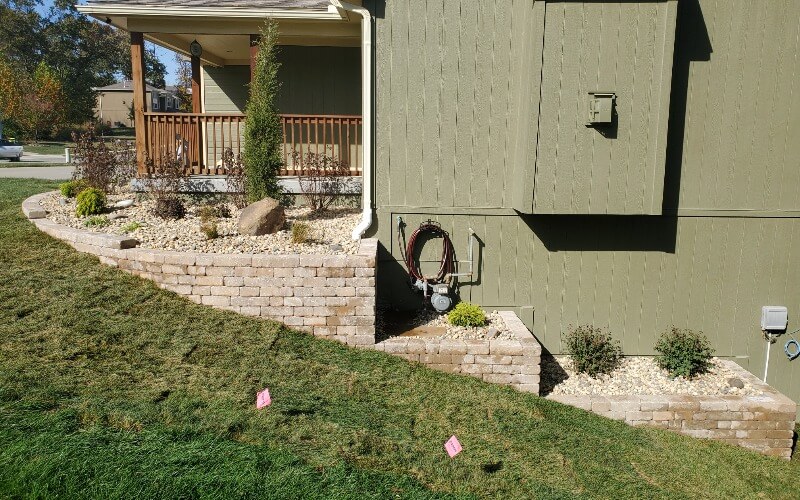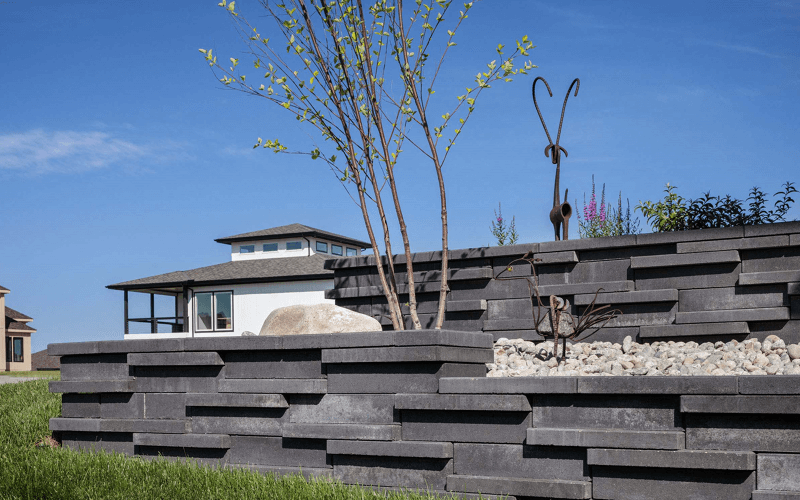North Kansas City, MO Retaining Wall Services
Superior Quality, Craftsmanship, & Service on Every Hardscaping Project in North Kansas City
Our Two Types of Retaining Walls
Segmental Retaining Wall (SRW) – Segmental retaining wall (SRW) block is also known as landscape block, castle block, pavestone, Belgard, or keystone. It is an aesthetically pleasing and economical material for retaining walls of all sizes and shapes. This versatile material is the backbone of many hardscape projects. These come in many sizes, shapes, and colors to fit any preference.
Natural Stone – This is a very viable retaining wall material. It can be more or less economical than SRW block depending on the location, site access, and appearance desired of the completed project. It can look like dry-stacked ledgestone, hand-stacked fieldstone, or masonry (mortared). This produces beautiful results, but some options can affect the cost of a project.

Retaining Walls On Your Property
Seating-Sitting Walls

Seating-sitting walls are perfect for defining a patio area to create a sense of outdoor space. This adds extra seating for entertaining or impromptu conversations. They are a great compliment when surrounding a fire pit. Seating-sitting walls also add a place to install low-voltage outdoor lights to brighten an outdoor space at night.
Garden Walls

A garden wall is generally more decorative than a structural retaining wall. We can still build them from the same SRW blocks or natural stone as a retaining wall. This could be a raised planting bed for flowers, a low wall to retain an A/C unit, or a division between your garden and lawn. Garden walls are the perfect way to add curb appeal to your front yard.
Structural Retaining Walls

Some slopes on your property can fail to hold up soil at a safe angle or have jagged-looking different levels. Structural retaining walls safely hold up soil and allow two different levels of your property. This helps divide your property and not only can help with appearance but with walking across your lawn.
Two Key Elements to Long Lasting Retaining Walls:
Compaction – The retaining wall block itself is only the facade of a retaining system. The structural integrity of this system is what is behind the wall and how it is prepared. This accounts for 90% of the retaining wall. Proper compaction of all materials underneath is crucial. To achieve this compaction we use a variety of equipment for different aggregate or soil types and compact in layers (lifts). This is something to consider when hiring a contractor for your project: Are they compacting all materials? Are they using the right equipment for compaction?
Drainage – This must be considered before the construction of a wall. We must address potential water anywhere around a retaining wall. There should be a minimum of 12″ of clean gravel behind the blocks and a footing drain. This channels any hydrostatic pressure that could occur behind the wall towards an outlet. If there are downspouts in the area, they should be buried and discharged elsewhere. The grading of the site is also a factor. The ground should be graded as needed to direct water flow.

Ready to Get Started?
Send us an email or give us a call and we'll get back to you soon!
